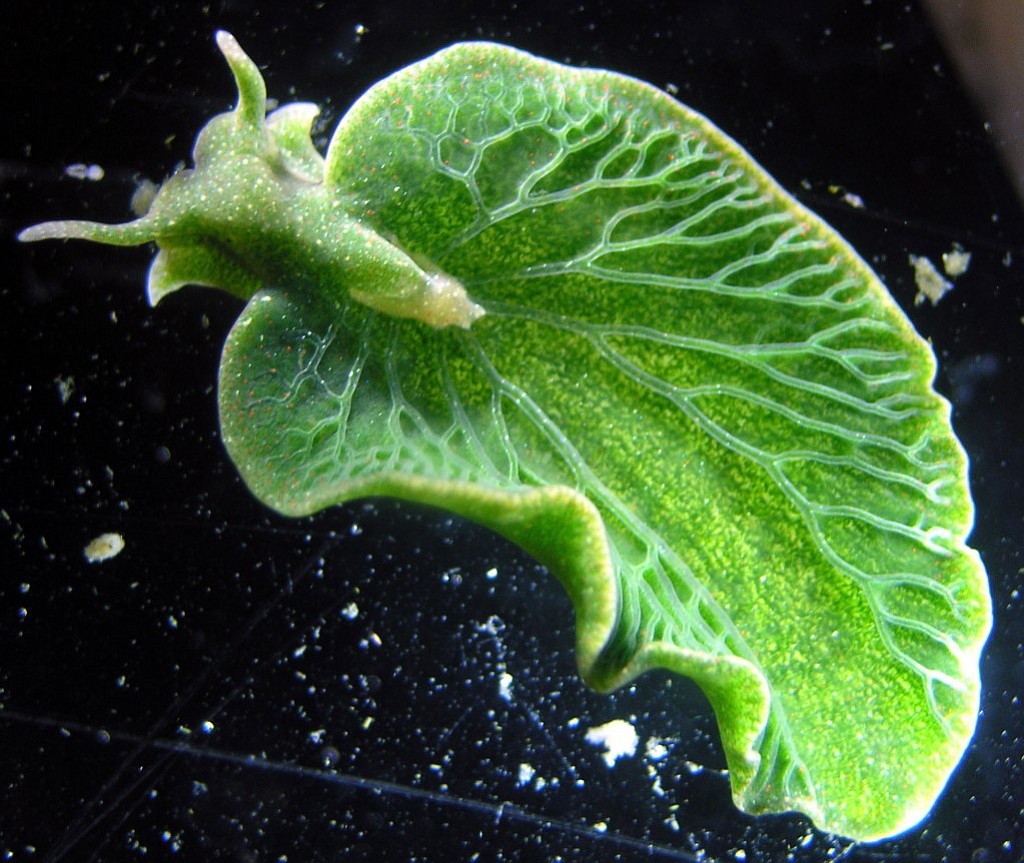The brilliant green sea slug Elysia chloroctica doesn’t just look like the leaf of a plant: It functions like one, too. When it’s supper time, the slug uses chloroplasts taken from local algae to photosynthesize for itself. That’s not news: Scientists have known about the chloroplast theft since the 1970s. But it turns out that the slug takes more than just the sunlight-processing chloroplasts. It also steals the algae genes it needs to maintain those food-factories long after the crime is committed.
In a paper published Tuesday in the Biological Bulletin, researchers report evidence that the sea slug’s chromosomes hoard algae genes.
“It’s been known for a long time that this particular group of sea slugs has a symbiotic relationship with chloroplasts they get from the algae they eat,” said study co-author Sidney K. Pierce, an emeritus professor at University of South Florida and at University of Maryland. When they eat algae, the cells that line their digestive systems can hold onto the chloroplasts inside.
But some of them do it much more efficiently than others, Pierce said. Some species need to get new chloroplasts every few days, and others can go their whole lives on one feeding.
Pierce and his colleagues went looking for an explanation as to how these sea slugs are able to reap the bounty of their algae pillages for so long. They’ve been known to photosynthesize for up to nine months after encountering the algae — an entire lifespan — maintaining the chloroplasts they’ve stolen for that entire time. But a borrowed piece of cellular machinery shouldn’t keep chugging along for such a long time in a foreign host.
“How can that possibly be? There’s a piece of a plant inside of an animal, and the animal isn’t designed to keep it going,” Pierce said. Even plants themselves tend to throw out their chloroplasts and start over every few days, he said. Photosynthesis is a destructive process, and the chloroplasts have to be repaired constantly.
“It’s fairly obvious that the sea slugs can’t make new chloroplasts,” Pierce said, “so they must be performing maintenance somehow.”
It turns out that Elysia chloroctica has a gene from the alga — one that produces an enzyme that helps the chloroplasts survive. And once stolen, the gene is passed down to future generations. Slugs of the next generation still need to find chloroplasts for themselves — feeding at least once at the beginning of their lives — but they inherit their ancestors’ ability to keep things running smoothly from that point forward.
Single-celled organisms like bacteria trade genes all the time, but this is the first observation of such a swap between multicellular creatures. Pierce and his colleagues actually found the first algal gene in a slug about a decade ago, then found around 50 in a follow-up study, but had to find a way to prove they were really there.
“Lots of people said we must have just been sloppy, that we had algal DNA splattered all over the lab and thought we were finding it in the slugs,” Pierce said. This time around, they introduced a synthetic copy of an algal gene into an uncontaminated sea slug. It bound right onto the slug’s chromosome, showing where the real algal gene sits on the slug’s DNA.
“I hope this study puts an end to all that, because there are more important things to look at now,” Pierce said. “This is a naturally occurring example of gene therapy working perfectly. None of it should work, but here it does. So we could keep looking for genes, but that’s kind of boring — I think the mechanism of the transfer is much more important to figure out.”
He said he hopes what they learn can be used to improve gene therapy on plants and people.
“Standard Darwinian evolution has you waiting around for a spontaneous mutation to occur. If it’s a good one, it gets shaped and vetted through the population over the course of millions of years,” he said. “Here you’re taking a gene that’s already been through all that evolutionary stuff, and it works overnight. It’s these peculiar symbioses, where things are evolving on the fly, that we should be paying attention to.”



